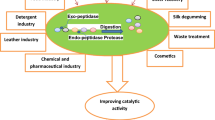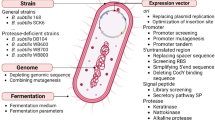Abstract
The HschiA1 gene of the archaeon Halobacterium salinarum CECT 395 was cloned and overexpressed as an active protein of 66.5 kDa in Escherichia coli. The protein called HsChiA1p has a modular structure consisting of a glycosyl hydrolase family 18 catalytic region, as well as a N-terminal family 5 carbohydrate-binding module and a polycystic kidney domain. The purified recombinant chitinase displayed optimum catalytic activity at pH 7.3 and 40 °C and showed high stability over broad pH (6–8.5) and temperature (25–45 °C) ranges. Protein activity was stimulated by the metal ions Mg+2, K+, and Ca+2 and strongly inhibited by Mn+2. HsChiA1p is salt-dependent with its highest activity in the presence of 1.5 M of NaCl, but retains 20 % of its activity in the absence of salt. The recombinant enzyme hydrolysed p-NP-(GlcNAc)3, p-NP-(GlcNAc), crystalline chitin, and colloidal chitin. From its sequence features and biochemical properties, it can be identified as an exo-acting enzyme with potential interest regarding the biodegradation of chitin waste or its bioconversion into biologically active products.





Similar content being viewed by others
References
Aam BB, Heggset EB, Norberg AL, Sørlie M, Vårum KM, Eijsink VGH (2010) Production of chitooligosaccharides and their potential applications in medicine. Mar Drugs 8:1482–1517
Aunpad R, Rice DW, Sedelnikova S, Panbangreb W (2007) Biochemical characterization of two forms of halo- and thermo-tolerant chitinase C of Salinivibrio costicola expressed in Escherichia coli. Ann Microbiol 57:249–257
Bagos PG, Tsirigos KD, Plessas SK, Liakopoulos TD, Hamodrakas SJ (2009) Prediction of signal peptides in archaea. Protein Eng Des Sel 22:27–35
Bhattacharya D, Nagpure A, Gupta RK (2007) Bacterial chitinases: properties and potential. Crit Rev Biotechnol 27:21–28
Bradford M (1976) A rapid and sensitive method for the quantitation of microgram quantities of protein utilizing the principle of protein-dye binding. Anal Biochem 72:248–254
Brun E, Moriaud F, Gans P, Blakledge MJ, Barras F, Marion D (1997) Solution structure of the cellulose-binding domain of the endoglucanase Z secreted by Erwinia chrysanthemi. Biochemistry 36:16074–16086
Cantarel BL, Coutinho PM, Rancurel C, Bernard T, Lombard V, Henrissat B (2009) The carbohydrate-active enzymes database (CAZy): an expert resource for glycogenomics. Nucleic Acids Res 37:233–238
Dahiya N, Tewari R, Hoondal GS (2006) Biotechnological aspects of chitinolytic enzymes: a review. Appl Microbiol Biotechnol 71:773–782
Delgado-García M, Valdivia-Urdiales B, Aguilar-González CN, Contreras-Esquivel JC, Rodríguez-Herrera R (2012) Halophilic hydrolases as a new tool for the biotechnological industries. J Sci Food Agric 92:2575–2580
Duo-Chuan L (2006) Review of fungal chitinases. Mycopathologia 161:345–360
Eichler J (2001) Biotechnological uses of archaeal extremozymes. Biotechnol Adv 19:261–278
Essghaier B, Hedi A, Bejji M, Jijakli H, Boudabous A, Sadfi-Zouaoui N (2012) Characterization of a novel chitinase from a moderately halophilic bacterium, Virgibacillus marismortui strain M3-23. Ann Microbiol 62:835–841
Gao J, Bauer MW, Shockley KR, Pysz MA, Kelly RM (2003) Growth of hyperthermophilic archaeon Pyrococcus furiosus on chitin involves two family 18 chitinases. Appl Environ Microbiol 69:3119–3128
Gomes J, Steiner W (2004) The biocatalytic potential of extremophiles and extremozymes. Food Technol Biotechnol 42:223–235
Han Y, Yang B, Zhang F, Miao X (2009) Characterization of antifungal chitinase from marine Streptomyces sp. DA11 associated with South China Sea sponge Craniella australiensis. Mar Biotechnol 11:132–140
Hatori Y, Sato M, Orishimo K, Yatsunami R, Endo K, Fukui T, Nakamura S (2006) Characterization of recombinant family 18 chitinase from extremely halophilic archaeon Halobacterium salinarum strain NRC-1. Chitin and Chitosan Research 12:201
Holmes PK, Dundas IED, Halvorson HO (1965) Halophilic enzymes in cell-free extracts of Halobacterium salinarium. J Bacteriol 90:1159–1160
Horn SJ, Sørbotten A, Synstad B, Sikorski P, Sørlie M, Vårum KM, Eijsink VG (2006) Endo/exo mechanism and processivity of family 18 chitinases produced by Serratia marcescens. FEBS J 273:491–503
Ishibashi M, Tokunaga H, Hiratsuka K, Yonezawa Y, Tsurumaru H, Arakawa T, Tokunaga M (2001) NaCl-activated nucleoside diphosphate kinase from extremely halophilic archaeon, Halobacterium salinarum, maintains native conformation without salt. FEBS Lett 493:134–138
Itoh Y, Watanabe J, Fukada H, Mizuno R, Kezuka Y, Nonaka T, Watanabe T (2006) Importance of Trp59 and Trp60 in chitin-binding, hydrolytic, and antifungal activities of Streptomyces griseus chitinase C. Appl Microbiol Biotechnol 72:1176–1184
Litchfield CD (2011) Potential for industrial products from the halophilic Archaea. J Ind Microbiol 38:1635–1647
Nelson N (1944) A photometric adaptation of the Somogyi method for the determination of glucose. J Biol Chem 153:375–380
Oku T, Ishikawa K (2006) Analysis of the hyperthermophilic chitinase from Pyrococcus furiosus: activity towards crystalline chitin. Biosci Biotechnol Biochem 70:1696–1701
Orikoshi H, Nakayama S, Hanato C, Miyamoto K, Tsujibo H (2005) Role of the N-terminal polycystic kidney disease domain in chitin degradation by chitinase A from a marine bacterium, Alteromonas sp. strain O-7. J Appl Microbiol 99:551–557
Prasad S, Khadatare PB, Roy I (2011) Effect of chemical chaperones in improving the solubility of recombinant proteins in Escherichia coli. Appl Environ Microbiol 77:4603–4609
Roberts WK, Selitrennikoff CP (1988) Plant and bacterial chitinases differ in antifungal activity. J Gen Microbiol 134:169–176
Sambrook J, Russell DW (2001) Molecular cloning: a laboratory manual, 3rd edn. CSHLP, New York
Shanmughapriya S, Kiran GS, Selvin J, Gandhimathi R, Baskar TB, Manilal A, Sujith S (2009) Optimization, production and partial characterization of an alkalophilic amylase produced by sponge associated marine bacterium Halobacterium salinarum MMD047. Biotechnol Bioproc Eng 14:67–75
Staufenberger T, Imhoff JF, Labes A (2012) First crenarchaeal chitinase found in Sulfolobus tokodaii. Microbiol Res 167:262–269
Suzuki K, Yaiyoji M, Sugawara N, Nikaidou N, Henrissat B, Watanabe T (1999) The third chitinase gene (chiC) of Serratia marcescens 2170 and the relationship of its product to other bacterial chitinases. Biochem J 343:587–596
Synstad B, Gåseidnes S, van Aalten DMF, Vriend G, Nielsen JE, Eijsink VGH (2004) Mutational and computational analysis of the role of conserved residues in the active site of a family 18 chitinase. Eur J Biochem 271:253–262
Tanaka T, Fujiwara S, Nishikori S, Fukui T, Takagi M, Imanaka T (1999) A unique chitinase with dual active sites and triple substrate binding sites from the hyperthermophilic archaeon Pyrococcus kodakaraensis. Appl Environ Microbiol 65:5338–5344
Tsuji H, Nishimura S, Inui T, Kado Y, Ishikawa K, Nakamura T, Uegaki K (2010) Kinetic and crystallographic analyses of the catalytic domain of chitinase from Pyrococcus furiosus—the role of conserved residues in the active site. FEBS J 277:1–13
Vaaje-Kolstad G, Horn SJ, Sørlie M, Eijsink VGH (2013) The chitinolytic machinery of Serratia marcescens—a model system for enzymatic degradation of recalcitrant polysaccharides. FEBS J 280:3028–3049
Wang SL, Lin BS, Liang TW, Wang CL, Wu PC, Liu JR (2010) Purification and characterization of chitinase from a new species strain, Pseudomonas sp. TKU008. J Microbiol Biotechnol 20:1001–1005
Acknowledgments
This work was developed within the Sustainable Use Network of Environmental and Agrifood Resources REDUSO and was supported by Grant 10PXIB310278PR (Xunta de Galicia). G.-F., B. has a predoctoral fellowship from the University of Vigo, Spain.
Author information
Authors and Affiliations
Corresponding author
Rights and permissions
About this article
Cite this article
García-Fraga, B., da Silva, A.F., López-Seijas, J. et al. Functional expression and characterization of a chitinase from the marine archaeon Halobacterium salinarum CECT 395 in Escherichia coli . Appl Microbiol Biotechnol 98, 2133–2143 (2014). https://doi.org/10.1007/s00253-013-5124-2
Received:
Revised:
Accepted:
Published:
Issue Date:
DOI: https://doi.org/10.1007/s00253-013-5124-2




